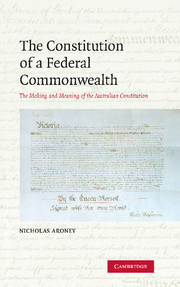Book contents
- Frontmatter
- Contents
- Preface
- Table of statutes and executive instruments
- Table of cases
- Introduction: Australia as a federal commonwealth
- PART I Federalism
- PART II Federating Australia
- PART III Australian federation
- 7 Principles of representation
- 8 Representative institutions
- 9 The states and the Commonwealth
- 10 Configurations of power
- 11 Amendment procedures
- PART IV Conclusions
- Select provisions
- Bibliography
- Index
9 - The states and the Commonwealth
Published online by Cambridge University Press: 05 August 2012
- Frontmatter
- Contents
- Preface
- Table of statutes and executive instruments
- Table of cases
- Introduction: Australia as a federal commonwealth
- PART I Federalism
- PART II Federating Australia
- PART III Australian federation
- 7 Principles of representation
- 8 Representative institutions
- 9 The states and the Commonwealth
- 10 Configurations of power
- 11 Amendment procedures
- PART IV Conclusions
- Select provisions
- Bibliography
- Index
Summary
[A federation is] a political union of several States, which, for certain purposes, and within certain limits, is complete, so that the several States form one larger State with a common Government acting directly upon the individual citizens as to all matters within its jurisdiction, while, beyond those limits, and for all other purposes, the separate States retain complete autonomy.
Samuel Griffith (1896)Statements of fundamental principle
The convention of 1891
Australian federation was premised on the principle, expressed in the first resolution introduced by Henry Parkes in Sydney in 1891, that:
the powers and privileges and territorial rights of the several existing colonies shall remain intact, except in respect to such surrenders as may be agreed upon as necessary and incidental to the power and authority of the National Federal Government.
In other words, Australian federation presupposed the existence of the several colonies as independent, self-governing bodies politic. Federation would involve establishment of a federal government, to which particular powers would be surrendered, but apart from those specific surrenders, the existing powers, privileges and territorial rights of the colonies would remain as they were prior to federation. Further, the objective would be to surrender those powers necessary and incidental to the establishment of a federal government, but the determination of precisely what was necessary and incidental would be a matter of agreement between the colonies themselves.
- Type
- Chapter
- Information
- The Constitution of a Federal CommonwealthThe Making and Meaning of the Australian Constitution, pp. 247 - 271Publisher: Cambridge University PressPrint publication year: 2009



